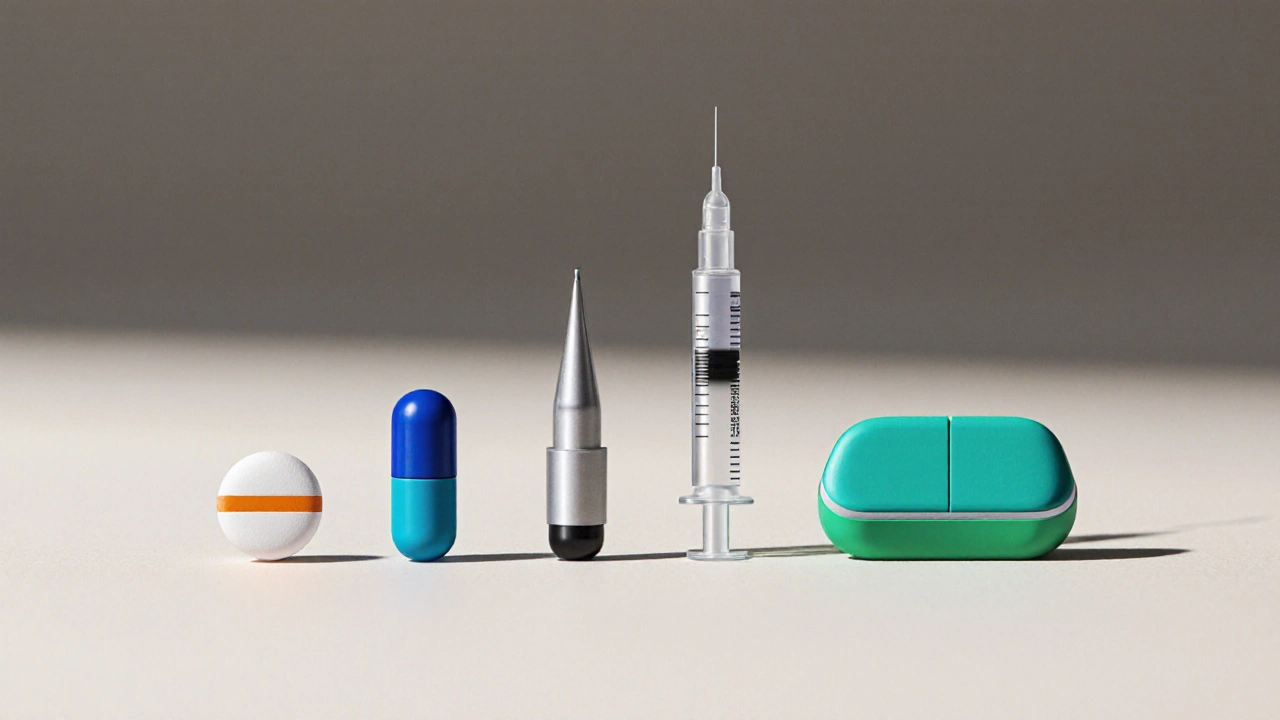Weight-Loss Drug Comparison Tool
| Medication | Mechanism | Typical Dose | Avg Weight Loss | Side Effects | Prescription? | Monthly Cost |
|---|
Key Insights
- Orlistat blocks fat absorption but requires strict dietary control.
- GLP-1 agonists offer the highest weight loss but are costly and require injections.
- Phentermine acts quickly but carries cardiovascular risks.
- Naltrexone-Bupropion provides moderate benefits with a balanced side effect profile.
Remember to consult with a healthcare provider before starting any weight-loss medication.
If you’re trying to shed pounds and have heard about Orlistat, you probably wonder how it measures up against other prescription or over‑the‑counter options. Below you’ll get a clear rundown of what Orlistat actually does, which drugs sit in the same lane, and what factors matter most when choosing a weight‑loss aid.
Quick Takeaways
- Orlistat blocks dietary fat absorption and is best for people who can stick to a low‑fat diet.
- GLP‑1 agonists like liraglutide and semaglutide deliver the greatest average weight loss (10‑15% of body weight) but require injections and higher cost.
- Appetite suppressants such as phentermine act fast but carry higher risk of cardiovascular side effects.
- Naltrexone‑bupropion offers moderate loss with a balanced side‑effect profile, suitable for patients with mild hypertension.
- Cost, insurance coverage, and personal health conditions often tip the scale more than raw efficacy numbers.
Let’s dig into the details.
How Orlistat Works
Orlistat is a lipase inhibitor that binds to gastrointestinal lipases, preventing them from breaking down about 30% of the fat you eat. The undigested fat is then excreted, which means you lose calories without affecting your appetite. Because the drug works in the gut, it doesn’t influence hormones that control hunger, so success largely depends on sticking to a reduced‑fat diet (usually under 30g of fat per day).
Typical dosage is 120mg taken with each main meal that contains fat, up to three times daily. It’s available over the counter in many countries under brand names like Xenical (prescription) and Alli (lower‑dose OTC).
Popular Alternatives at a Glance
Below are the most common weight‑loss drugs you’ll encounter. Each has a distinct mechanism, efficacy range, and side‑effect profile.
- Phentermine is a sympathomimetic amine that suppresses appetite by stimulating the central nervous system.
- Liraglutide is a GLP‑1 agonist that slows gastric emptying and reduces hunger signals.
- Semaglutide is a longer‑acting GLP‑1 agonist administered once‑weekly, offering the highest weight‑loss percentages among injectable options.
- Naltrexone‑Bupropion combines an opioid antagonist with a dopamine‑norepinephrine reuptake inhibitor to curb cravings and boost energy expenditure.
- Bariatric‑Surgery (mentioned for context) is a procedural alternative that physically restricts food intake or nutrient absorption.

Side‑Effect Snapshot
- Orlistat: oily spotting, flatulence, urgent need to defecate after high‑fat meals.
- Phentermine: increased heart rate, insomnia, dry mouth, potential for dependence.
- Liraglutide: nausea, vomiting, mild pancreatitis risk.
- Semaglutide: similar to liraglutide but with higher incidence of gastrointestinal upset.
- Naltrexone‑Bupropion: headache, nausea, possible elevation in blood pressure.
Head‑to‑Head Comparison Table
| Medication | Mechanism | Typical Dose | Average Weight Loss (% of initial body weight) | Common Side Effects | Prescription? | Monthly Cost (US$) |
|---|---|---|---|---|---|---|
| Orlistat | Lipase inhibition (blocks fat absorption) | 120mg with each main meal (up to 3×/day) | 3‑5% | Oily spotting, flatulence, abdominal cramping | Both OTC (low dose) and prescription (high dose) | ≈$30(OTC) - $120(prescription) |
| Phentermine | Central nervous system stimulant (appetite suppressant) | 15‑37.5mg daily | 5‑10% | Elevated heart rate, insomnia, dry mouth | Prescription | ≈$40(monthly) |
| Liraglutide | GLP‑1 agonist (slows gastric emptying, reduces appetite) | 1.2mg daily injection | 8‑10% | Nausea, vomiting, possible pancreatitis | Prescription | ≈$900(monthly) |
| Semaglutide | Long‑acting GLP‑1 agonist (enhances satiety) | 2.4mg weekly injection | 12‑15% | Nausea, diarrhea, injection site reactions | Prescription | ≈$1,300(monthly) |
| Naltrexone‑Bupropion | Opioid antagonist + dopamine‑norepinephrine reuptake inhibitor (targets cravings) | 8mg/90mg twice daily | 5‑7% | Headache, nausea, possible blood pressure rise | Prescription | ≈$300(monthly) |
Choosing the Right Option for You
When you sit down with your clinician, keep these decision points front and center:
- How much weight do you need to lose? If you’re aiming for a modest 5‑10% reduction, Orlistat or phentermine may be sufficient. For higher targets (>12%), GLP‑1 agonists are generally more effective.
- Do you have existing medical conditions? Cardiovascular disease, uncontrolled hypertension, or a history of pancreatitis can rule out stimulants like phentermine or GLP‑1 drugs respectively.
- Can you commit to a low‑fat diet? Orlistat’s success hinges on dietary fat control; otherwise the drug’s benefit plateaus.
- What’s your budget? Out‑of‑pocket costs can vary dramatically. Insurance may cover GLP‑1 agonists for patients with a BMI ≥30kg/m² plus comorbidities.
- Do you mind injections? If self‑administering a syringe sounds off‑putting, oral options (Orlistat, phentermine, naltrexone‑bupropion) are more convenient.

Practical Tips & Common Pitfalls
- Pair Orlistat with a balanced, low‑fat diet. Track your daily fat intake; many apps let you set a 30‑gram limit.
- Take a daily multivitamin containing vitamins A, D, E, and K at least 2hours apart from Orlistat to avoid malabsorption.
- If you experience persistent oily spotting, reduce dietary fat further before assuming the drug isn’t working.
- Never combine phentermine with other stimulants (e.g., caffeine pills) without medical guidance.
- When starting GLP‑1 agents, start at the lowest dose and titrate up slowly to minimize nausea.
Next Steps: Talk to Your Healthcare Provider
Bring a short list of your goals, any current meds, and a rough idea of your budget to the appointment. Ask about insurance coverage for the drug you’re leaning toward, and request a clear plan for monitoring side effects (e.g., liver enzymes for Orlistat, blood pressure for phentermine).
Frequently Asked Questions
Can I take Orlistat if I’m pregnant?
Orlistat is not recommended during pregnancy because it can affect the absorption of essential fatty acids needed for fetal development. Talk to your doctor about safer options.
How quickly can I see results with Orlistat?
Most users notice modest weight loss (about 0.5kg per month) after 4‑6weeks if they stick to a low‑fat diet and take the medication with every meal that contains fat.
Is Orlistat safe for people with diabetes?
Yes, many diabetic patients use Orlistat safely, but monitoring blood sugar is essential because changes in calorie absorption can affect medication dosing.
What makes GLP‑1 drugs more effective than Orlistat?
GLP‑1 agonists act on brain pathways that control hunger, leading to reduced calorie intake and improved satiety, whereas Orlistat only blocks fat absorption without influencing appetite.
Can I switch from Orlistat to a GLP‑1 drug?
You can, but do it under medical supervision. Your doctor will likely taper off Orlistat and start the GLP‑1 at a low dose to gauge tolerance and adjust any other weight‑loss strategies.







Pat Mills
October 10, 2025 AT 20:08 PMWhen it comes to battling the stubborn pounds, Americans love to champion the home‑grown miracle that promises to melt fat away without any willpower, and Orlistat is often paraded as that very beacon of hope. First, understand that Orlistat is a lipase inhibitor, meaning it literally blocks the enzyme that would otherwise break down dietary fat into absorbable molecules. By preventing roughly thirty percent of the fat you ingest from being absorbed, it forces the body to excrete that caloric load, which translates to modest weight loss over time. However, the drug does not whisper sweet nothings to your appetite; you still have to tame your cravings and watch your diet, especially the fat content, otherwise you’ll be greeted by oily spotting and embarrassing flatulence. The typical dosage is 120 mg taken with each main meal containing fat, up to three times daily, and the over‑the‑counter version comes in a lower dose under the name Alli, while the prescription strength is sold as Xenical. Clinical studies show an average weight loss of three to five percent of body weight after a year, which, while not groundbreaking, can be a solid start for many who are just beginning their journey. Cost‑wise, the OTC version runs about thirty dollars a month, whereas the prescription can climb to a hundred twenty dollars, a price point that still undercuts the pricey GLP‑1 injectables that can cost nine hundred to thirteen hundred dollars per month. Side effects are largely gastrointestinal – oily stool, urgent bowel movements, and occasional abdominal cramping – and they tend to subside once you trim dietary fat to under thirty grams per day. It is also crucial to take a multivitamin at least two hours apart from the medication, because the reduced fat absorption can lead to deficiencies in fat‑soluble vitamins A, D, E, and K. For patients with diabetes, Orlistur has been used safely, but blood glucose monitoring remains essential, as changes in caloric intake can affect insulin needs. If you have a history of pancreatitis, you’ll want to avoid the GLP‑1 class altogether, but Orlistat poses no direct risk in that regard. In contrast, stimulants like Phentermine can raise heart rate and blood pressure, making Orlistat a gentler alternative for those with cardiovascular concerns. Yet, for individuals aiming for high‑impact weight loss – say, more than twelve percent of body weight – the GLP‑1 agonists such as Semaglutide or Liraglutide often outshine Orlistat in efficacy, albeit at a steep cost and the inconvenience of weekly or daily injections. Bottom line: Orlistat can be an effective tool when paired with a disciplined low‑fat diet, vigilant vitamin supplementation, and realistic expectations about the modest scale of weight loss it delivers. So before you dismiss it as a weak cousin of the more glamorous injectables, consider whether your budget, tolerance for GI side‑effects, and commitment to dietary changes align with what Orlistat offers. Remember, the best weight‑loss strategy is the one you can stick to consistently, and for many Americans, that consistency comes from a cheap, oral pill that simply takes the fat out of the equation.
neethu Sreenivas
October 22, 2025 AT 12:08 PMHey there 😊 I totally get how overwhelming the sea of weight‑loss meds can feel, especially when every article promises a magic bullet. Orlistat is actually pretty humble – it just blocks fat absorption, so you’ve got to pair it with a low‑fat diet to see results. The upside is that it’s oral and far cheaper than the GLP‑1 injectables, which can save you hundreds each month. On the flip side, be ready for some oily spotting and the occasional urgent bathroom dash after a fatty meal. A good tip is to take a daily multivitamin two hours apart from the pill so you don’t miss out on vitamins A, D, E, and K. If you’re diabetic, keep an eye on your blood sugar because the caloric shift can tweak your insulin needs. 😊 Remember, no drug works miracles without lifestyle changes, so stay kind to yourself and celebrate the small wins! 🌟
Keli Richards
November 3, 2025 AT 03:08 AMOrlistat works by stopping fat from being broken down it’s simple and cheap but you still need to watch what you eat and take a multivitamin later for safety
Ravikumar Padala
November 14, 2025 AT 19:08 PMHonestly looking at the numbers Orlistat’s 3‑5% weight loss over a year feels underwhelming when you compare it to the 12‑15% you can get from Semaglutide, but not everyone can afford or tolerate injectables. The drug’s main selling point is that it’s an oral tablet you can get without a prescription in many places, which lowers the barrier for people who are just starting out. Still, the gastrointestinal side effects can be pretty brutal if you slip up on your fat intake, and you’ll have to commit to a low‑fat diet to avoid the oily mess. It’s a trade‑off: cheap, safe for most, but modest results and a lot of diet discipline. If you have a history of heart issues, you might actually prefer Orlistat over Phentermine, which can spike your heart rate. Bottom line, it’s a decent option for mild weight loss if you’re willing to put in the diet work and don’t mind the occasional bathroom urgency.
King Shayne I
November 26, 2025 AT 11:08 AMYo this Orlistat stuff is real cheap but dont expect miracles lol its just a fat blocker dont be a fool and think its a magic pill its all about diet ya know
jennifer jackson
December 8, 2025 AT 03:08 AMGive Orlistat a try it could be the gentle start you need 💪